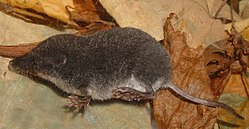| Mediterranean water shrew | |
|---|---|
 | |
| Scientific classification | |
| Kingdom: | Animalia |
| Phylum: | Chordata |
| Class: | Mammalia |
| Order: | Eulipotyphla |
| Family: | Soricidae |
| Genus: | Neomys |
| Species: | N. milleri |
| Binomial name | |
| Neomys milleri Mottaz, 1907 | |
 | |
| Mediterranean water shrew range. The shrews in the Iberian peninsula are now recognised as a separate species, Neomys anomalus . | |
| Synonyms | |
Neomys anomalus milleri | |
The Mediterranean, Southern or Miller's water shrew (Neomys milleri) is a species of insectivoran mammal in the family Soricidae. [1] [2] [3]
